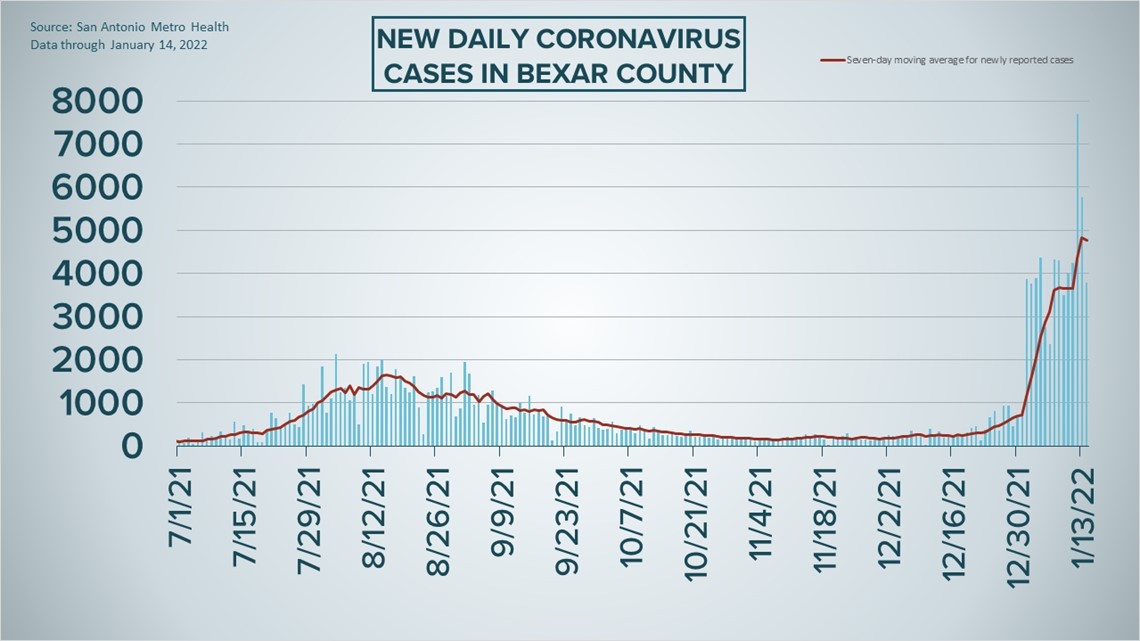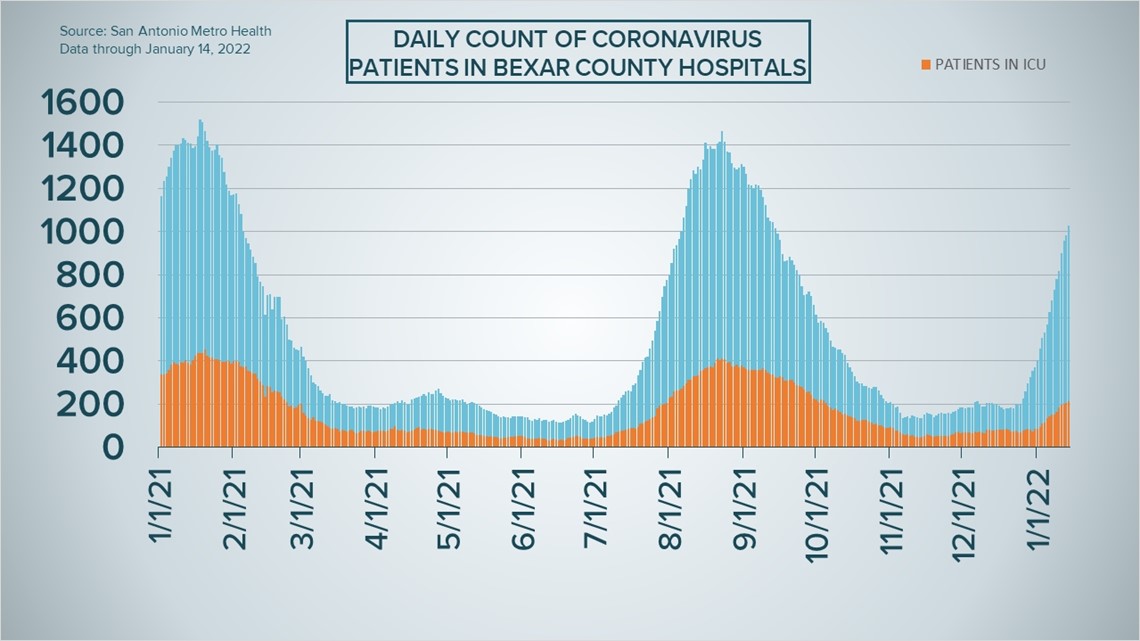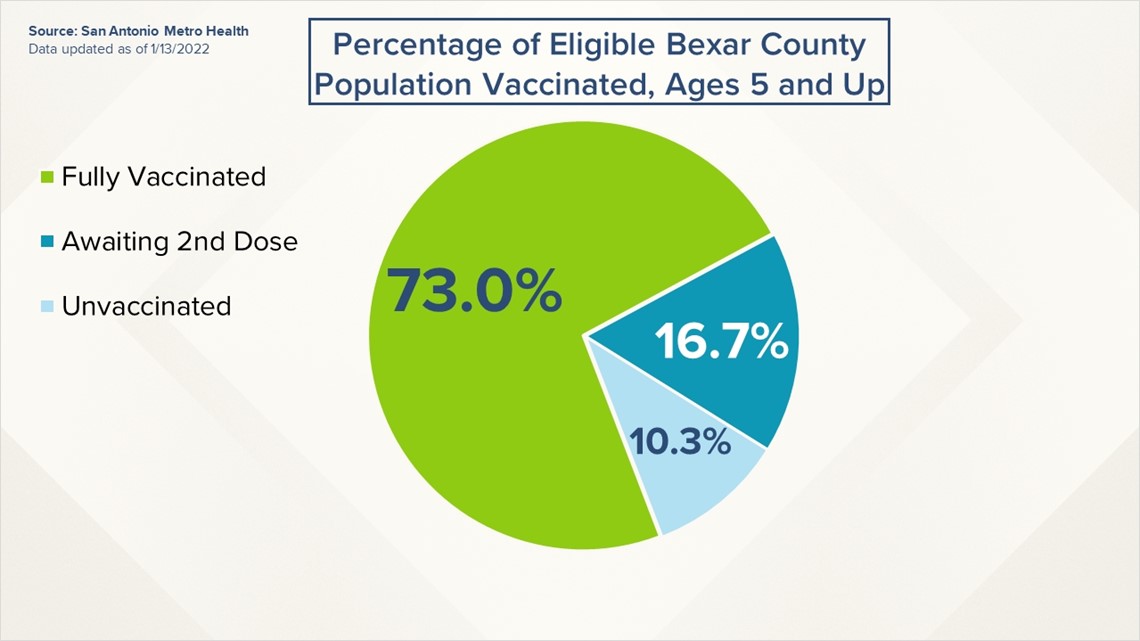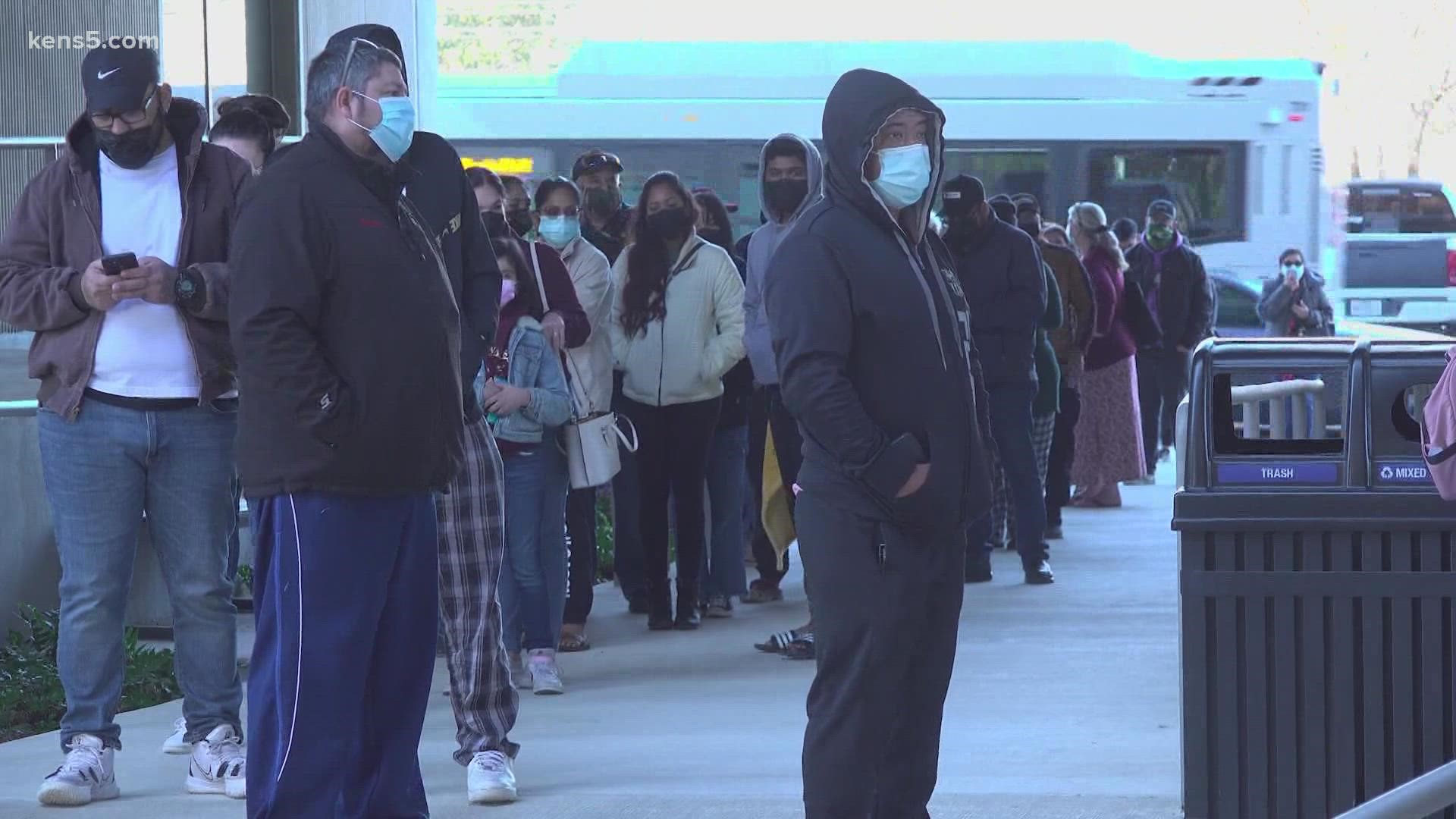SAN ANTONIO — After reporting the two highest new-case counts of the ongoing COVID-19 pandemic, San Antonio-area health authorities tallied 3,796 new diagnoses on Friday—making it a near certainty Bexar County will reach 400,000 total cases by Monday.
Though 3,796 is the lowest case count in several days, it's still a higher figure than any day in 2021; Metro Health officials recorded just one day of at least 3,000 cases all of last year.
The death toll, meanwhile, remained at 5,006 after no new deaths from coronavirus complications were reported.
The highly contagious omicron wave continues to put newfound strain on hospitals, too. On Friday 1,028 county residents were receiving treatment at local facilities for COVID-19, the first time there were more than 1,000 local patients since Sept. 14. Of those, 214 are in intensive care and 76 are using ventilators.
And UT researchers say they expect hospitalizations to go up for a few more weeks, with Texas potentially doubling its record of COVID-19 patients, though infections should be less severe than prior variants.
In the meantime, more no-cost testing sites opened around San Antonio this week, with no appointment needed prior to arriving. Starting next week, American families will be able to request free at-home tests as the federal government works to address the latest wave.
How Bexar County is trending




Vaccine Progress in Bexar County
The following numbers are provided by San Antonio Metro Health. A full breakdown can be found here.
- 1.699 million eligible Bexar County residents have received at least one dose of the coronavirus vaccine as of Thursday, Jan. 13, representing 89.7% of the county's population eligible (those over the age of 4) to receive a vaccination.
- 1.383 million eligible Bexar County residents are fully vaccinated as of Thursday, Jan. 13, representing 73% of the county's population eligible to receive a vaccination.


The CDC states that "when a high percentage of the community is immune to a disease (through vaccination and/or prior illness)," that community will have reached herd immunity, "making the spread of this disease from person to person unlikely."
The City of San Antonio breaks down the vaccination rates by zip code on Metro Health's Vaccination Statistics page.
Coronavirus in Texas
The total number of coronavirus cases in the state since the pandemic began grew by 57,874 on Friday, according to the Texas Department of State Health Services. That total includes 48,390 new confirmed cases and 9,484 new probable cases. More details can be found on this page.
Friday's figures bring the total number of Texans diagnosed with COVID-19 to more than 5.402 million.
An additional 133 Texans have died from virus complications, meanwhile, raising the statewide death toll to 75,783.
Coronavirus symptoms
The symptoms of coronavirus can be similar to the flu or a bad cold. Symptoms include fever or chills, cough, shortness of breath or difficulty breathing, fatigue, muscle or body aches, headache, new loss of taste or smell sore throat, congestion or runny nose, nausea or vomiting, and diarrhea, according to the Centers for Disease Control.
Most healthy people will have mild symptoms. A study of more than 72,000 patients by the Centers for Disease Control in China showed 80 percent of the cases there were mild.
But infections can cause pneumonia, severe acute respiratory syndrome, kidney failure, and even death, according to the World Health Organization. Older people with underlying health conditions are most at risk.
Experts determined there was consistent evidence these conditions increase a person's risk, regardless of age:
- Chronic kidney disease
- COPD (chronic obstructive pulmonary disease)
- Obesity (BMI of 30 or higher)
- Immunocompromised state (weakened immune system) from solid organ transplant
- Serious heart conditions, such as heart failure, coronary artery disease, or cardiomyopathies
- Sickle cell disease
- Type 2 diabetes
- The CDC believes symptoms may appear anywhere from two to 14 days after being exposed.
Human coronaviruses are usually spread...
- Between people who are in close contact with one another (within about 6 feet).
- Through respiratory droplets produced when an infected person coughs, sneezes or talks. These droplets can land in the mouths or noses of people who are nearby or possibly be inhaled into the lungs.
- Some recent studies have suggested that COVID-19 may be spread by people who are not showing symptoms.
Help stop the spread of coronavirus
- Stay home when you are sick.
- Eat and sleep separately from your family members
- Use different utensils and dishes
- Cover your cough or sneeze with your arm, not your hand.
- If you use a tissue, throw it in the trash.
Find a Testing Location
City officials recommend getting a COVID-19 test if you experience fever or chills, cough, shortness of breath or difficulty breathing, fatigue, muscle or body aches, headache, new loss of taste or smell, sore throat, congestion or runny nose, nausea or vomiting, or diarrhea.
Here's a Testing Sites Locator to help you find the testing location closest to you in San Antonio.
Latest Coronavirus Headlines
- After OSU study claims acids in hemp can prevent COVID-19, health experts say more research is needed
- Coronavirus Tracker: Virus-related deaths surpass 5,000 in Bexar County
- 'Our residents are vaccinated and boosted' | New report shows spiking cases of omicron variant in nursing homes nationwide
- Supreme Court halts COVID-19 vaccine-or-test rule for large businesses, keeps health care worker mandate
- Biden to double free COVID tests, add N95s, to fight omicron
- U.S. jobless claims rise by 23,000 to 230,000, 1.6 million collecting unemployment
- Texas could double its COVID-19 hospitalization record, models say
- More mass COVID-19 testing sites coming to San Antonio
- If you have these COVID tests at home, stop using them, FDA says
- When am I contagious if infected with omicron?
- What's the best way to tell if it's a cold, the flu or COVID?

